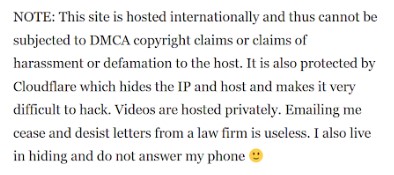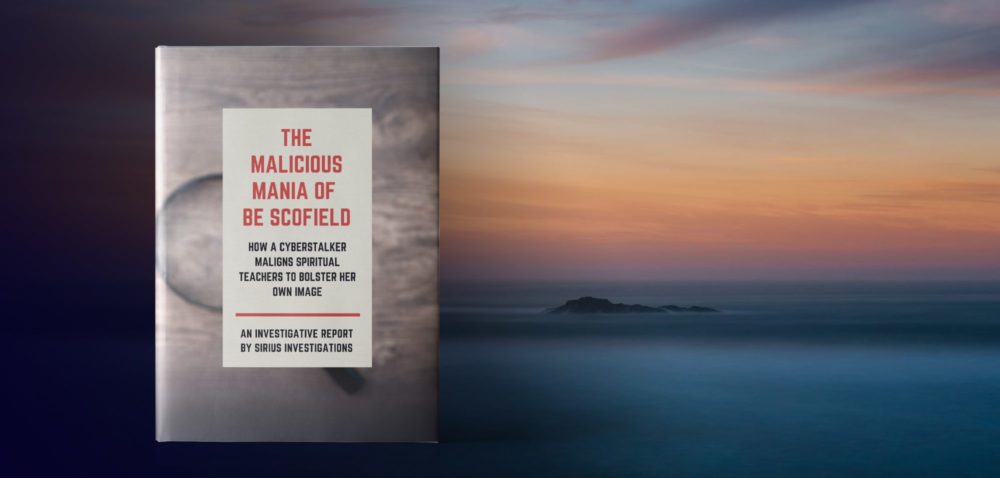More Than Twelve Years Later, Be Scofield Mysteriously Arrives on Orcas
Although neither Reed Goodrich nor Jim Shaffer-Bauck were able to interest the local media in publicizing their unsubstantiated theories on Carla’s death, someone did not want to let the case end with the official verdict of accidental drowning. That person or persons was determined to implicate Aaravindha, and gave Be Scofield the opportunity to tell the world that a dangerous cult had killed Carla, or at least convinced Carla to take her own life. So, that someone contacted Be Scofield, who very quickly published a highly defamatory article on her own website, gurumag.com: “Aaravindha Himadra and the Mysterious Orcas Island Death of Carla Jean Shaffer.”
It’s a very long blog post that also appears in the police records, and so has therefore become public record. You can find Scofield’s article in Appendix B at the end of this report.
Be Scofield is a self-designated “cult reporter.” She was born male, and identifies herself in her internet writings as a “queer/transgendered individual.” Scofield is commonly seen with a scarf wrapped around her head, as pictured on her gurumag.com and bescofield.com websites. This “turban” seems to have become her trademark uniform. Here’s one of her photos that she commonly posts on the internet:
 But clothing, appearance, and even gender are largely irrelevant in the larger scheme of things. She has a master’s degree in Divinity, and no evidence of journalism training. When her articles first began to appear, some were thoughtful discussions of the subject matter she chose. But somewhere along the way, she became totally focused on making herself the star of her own show, a self-proclaimed “cult hunter.”
But clothing, appearance, and even gender are largely irrelevant in the larger scheme of things. She has a master’s degree in Divinity, and no evidence of journalism training. When her articles first began to appear, some were thoughtful discussions of the subject matter she chose. But somewhere along the way, she became totally focused on making herself the star of her own show, a self-proclaimed “cult hunter.”
Scofield seems to be obsessed with the word “guru” and the idea of dangerous cults everywhere. She fits the description of a “cultphobe,” as described later in this section.
She has written articles and blog posts that claim to expose abuses within cults. We did not investigate her claims about other spiritual leaders, but based on her “reporting” in this particular case, it’s likely she did little to no investigation, interviewed only the disgruntled types she could find, and used the same tactics of gluing together juicy bits of gossip to accuse other spiritual teachers of a variety of crimes and unethical behaviors.
Scofield doesn’t need first-hand knowledge or actual evidence to level an accusation at any victim. Her principal weapon is innuendo, the suggestion that a person is guilty of something heinous, or that people associated with that person are part of a “cult.”
A quick Google search of “Be Scofield” will turn up many articles she’s written, nearly all of them posted on her own websites. Scofield owns and publishes on at least four URLs: decolonizingyoga.com, gurumag.com, agamajustice.com, and—of course—bescofield.com. She also uses Facebook and LinkedIn and other social sites to praise herself and promote her reputation.
How does Scofield fund all her “cult-hunting” activities? Many people we spoke to asked that question. All her websites include handy links for donations, and she often asks for donations on Facebook as well, but it seems probable that she has other sources of money, possibly from large cult-phobic organizations.
All her websites proclaim her cult journalism expertise. The description of Be Scofield on these sites was written by Be Scofield herself.
On her bescofield.com website, Scofield claims that every article that mentions her is “based on her reporting.” She also claims to be regularly invited to appear on The Dr. Phil Show, Leah Remini’s A&E Cult Series, movie networks, documentary film makers and producers. Why, then, if she is a professional journalist and expert in her field, has she never appeared on those shows? It should also be noted that all the enthusiastic “reviews” posted on her bescofield.com website include no identification of the sources of the accolades. It seems likely that not only does Scofield report on herself as if she were a third party telling the story, but she also writes her own reviews.
On various websites, Be Scofield has claimed to be represented by United Talent Agency. Our investigator called the agency. Julianne, the UTA employee who answered the phone, said, “That is definitely a lie. Be Scofield is definitely NOT represented by UTA.” Our investigator asked if Scofield was represented by their subsidiary, Greater Talent out of NYC, or if Scofield was part of their speaker’s bureau. Julianne said, “Be Scofield is in none of our agencies, on none of our lists.” She said she would be turning the matter over to their legal department.
Most of Scofield’s posts appear on gurumag.com under the title of “The Guru” (a reference to Be Scofield’s self-image?). The site also includes a subtitle of “Exposing Cults & Spiritual Abuse,” thus insinuating evil intentions and deeds to the subject of each of Scofield’s articles by an article’s mere presence on her website.
Scofield also has at least one Facebook page, and has been known to represent herself using a variety of names and personalities, including Metta Peace, Shakti Hunter, and Jamie. Traveler99, who regularly posts in the forum on culteducation.com, is also likely to be a name used by Be Scofield, because Traveler99 has posted links to information known only to Scofield, and repeatedly praises Be Scofield. The site reallyguru.com also praises Be Scofield and includes links to her writings, as well as posts that continue to denigrate Aaravindha, so that information is also likely posted by Be Scofield herself. She routinely uses multiple email addresses.
Self-adulation is a hallmark of Be Scofield’s work. She rarely posts anything without praising herself. She often repeats her accusations about her victims in a multitude of places, using different names to make it seem as though the information is coming from multiple sources.
Scofield stated right on her website that she is not subject to copyright laws. The screenshot shown below is from the “About the Guru” page on gurumag.com. This information was posted on the website when she wrote her defamatory article on Himadra in 2019. Scofield has since removed the statements about cloaking her gurumag.com website information and living in hiding, but the current version still claims she is not subject to copyright laws.
It’s clear that Be Scofield believes she should be able to evade all normal laws and ethics standards, because that’s what she plans to do.
This is not how professional journalists behave. This is how internet trolls behave.
 A screen capture from the About page on gurumag.com in 2019,
A screen capture from the About page on gurumag.com in 2019,
where Scofield admits to evading the law. Scofield has since edited this page to remove or hide some of this information.
Scofield seems to have become convinced of her superpowers in identifying and exposing cults after she wrote about Bentinho Massaro in 2017. The internet audience loves a scandal, and due to the way Google and other search engines work, Scofield’s blog post on Massaro received an avalanche of online attention. Scofield mentions that story at every opportunity. She even recently self-published a book glorifying her self-proclaimed successes in exposing “cults.” She likes to write especially about those supposedly led by Massaro and Himadra. The book is available only from her website bescofield.com, which allows her to conveniently gather any buyer’s contact information and avoid reviews on Amazon and other reputable bookselling sites.
Multiple articles have been written criticizing Be Scofield’s tactics and unsubstantiated conclusions. Two of the best and most thorough are “Cult Mania: Inside the Attack on Bentinho Massaro: Parts 1 and 2” by Alexander Vera, posted on medium.com (a site that has banned Be Scofield) in January of 2018.
Scofield’s targets are many. Because she has been known to use multiple names, it’s hard to keep track of her victims. We have not investigated her claims about others, but based on her standard methodology, her accusations are likely to lack any credible sources and be only her opinions, based on malicious gossip she was able to dig up. At the time of this writing, she has attacked the following individuals (list in no particular order):
- Dalai Lama
- Byron Katie
- Abraham Hicks
- Eckhart Tolle
- Aaravindha Himadra
- Teal Swan
- Uma Inder
- TJ Bartel
- Andrew Barnes
- Robert Masters
- Padma Aon Prakasha
- Alex Vartman
- Bentinho Massaro
- Swami Vivekananda
- Mooji (Portugal)
- California Institute of Integral Studies
- Shantan Nityama
- Actor Gano Grills
- Andrew Cohen
Yes, even the Dalai Lama has been criticized by Be Scofield. After all, he has many devoted followers, and as previously mentioned, Scofield fancies herself a heroine who exposes “cults.”
But how does Scofield identify a cult? It’s a term that immediately inflames the imagination, bringing to mind Jim Jones’s Jonestown, Heaven’s Gate, the Branch Davidians, Charlie Manson’s Girls, and other groups with charismatic leaders who persuaded their followers to commit crimes or take their own lives.
The definition of “cult” has changed over the years, as described in several scholarly articles, many by Dr. James T. Richardson, Professor of Sociology and Judicial Studies, and the Director of the Master of Judicial Studies Degree Program at the University of Nevada, Reno. Richardson specializes in social and behavioral science evidence, sociology of religions and new religious movements, sociology of law, and social movements.
In his paper “Definitions of Cult: From Sociological-Technical to Popular-Negative,” (Review of Religious Research, vol. 34, no. 4), Richardson describes an earlier definition of “cult” as meaning almost any group “deriving its inspiration and ideology from outside the predominant religious culture.”
Later, a much more negative definition of “cult” (delineated by Robbins and Anthony) became more popular:
certain manipulative and authoritarian groups which allegedly employ mind control and pose a threat to mental health…usually (1) authoritarian in their leadership; (2) communal and totalistic in their organization; (3) aggressive in their proselytizing; (4) systematic in their programs of indoctrination; (5) relatively new and unfamiliar in the United States; and (6) middle class in their clientele.
Richardson includes information from a psychologist, Jeffrey Pfeiffer, about how applying the word “cult” to any group will cause people to think negatively about that group. Pfeiffer developed a scenario of someone joining a group and going through its indoctrination process. He had 100 subjects read the scenario, which was similar in all respects except in some cases the group was identified as a cult (the Unification Church) and in other cases the person was described as joining the Catholic seminary or the Marines. Afterwards, the subjects tended to describe in negative terms both the group (74% negative) and the individual joining the group (82% negative) when they were led to believe the group was a cult.
Richardson concludes by recommending the term “cult” be severely limited in writings about religious groups. He says:
to do otherwise promotes the agenda of those deliberately using the term as a social weapon against new and exotic religious groups and experiences…
In an earlier paper, “Cultphobia,” written with Brock K. Kilbourne, Dr. Richardson describes how it is easier and safer to have an anti-cult perspective, and the article describes the need to “start researching the (anti-cult) researcher.” Here are a few short excerpts from “Cultphobia”:
Consider, for example, the widespread belief among anti-cultists that some kind of psychopathology characterizes new religious movements. Members of new religions, from this this perspective, are presumably disturbed psychologically before, during and/or after affiliation with the group. This same argument, however, can be plausibly made about some members of the ACM (Anti-Cult Movement), especially those individuals who persist in their fears of new religions or magnify such fears despite evidence to the contrary. Psychological disturbance of some kind is probably more likely among those anti-cultists who feel a compulsion to eradicate all new religions wherever they can be uncovered.
It is evident, then, that new religious members (derogatively called cultists) and new religions (derogatively called cults) are frequently stimuli of dread and irrational panic to some people. A reasonable interpretation of this response in some individuals, given the weak evidence of the actual danger of new religions to most people and the magnitude of the persistent fear evoked in some, is that we are dealing in some cases with a phobic reaction. … These cultphobes generally deny the right of new religions or cults to exist as well as the right of individuals to participate in such groups.
Like other phobias, it (cultphobia) constitutes a persistent fear of an object (i.e., the cults) that presents no actual danger to the person, or some magnification of danger beyond the actual seriousness of the threatening object.
These reactions present the greatest danger to the individual in terms of long-term adjustment and impairment. These cultphobes redefine their entire lives around the “fight” against the spread of the cults.
Experts agree that the word “cult” is a label guaranteed to attract the attention of everyone who delights in scandals and conspiracy stories. The word is a weapon, and Scofield wields it frequently and recklessly, because she knows that many in her internet audience will accept that label without question.
In his “Cult Mania” article on medium.com, Alexander Vera describes how some negative key words are guaranteed to attract attention via the internet. He starts by detailing how the word “scam” can be attached to almost anything to garner more “hits.” Then Vera goes on to explain how Be Scofield takes advantage of the internet’s adoration of negativity in her article on Bentinho Massaro:
But Scofield is smart, because the internet loves a negative review doesn’t it? Do you know another word that can drive almost as much traffic to a webpage as the word scam? You guessed it, “cult.” Scofield uses it a total of 62 times in the entirety of her report.
This is why the internet is simultaneously the greatest place and absolute worst place on earth. You can Google just about anything, and there’s always going to be at least one asshole who hates it. Oprah, Gandhi, Chick-fil-A, the NutriBullet. I don’t care what it is, someone out there hates it and has posted a negative review somewhere. Such is the case with Bentinho Massaro. Scofield is capitalizing on society’s love affair with scandals, public humiliation, and bad publicity. Ironically, spiritual gurus are pretty much the most volatile subject matter out there. I don’t care who it is, nothing incites internet outrage, bad press and negative reviews like a spiritual master.
Yes, Scofield hit on a magic attention-grabbing formula in her Bentinho Massaro article, and she used it again in her article on Aaravindha, where she repeated the word “cult” 32 times.
If a cult is a group with members and a leader, then nearly every organization is a cult. If it’s a group with leaders who teach their followers, then wouldn’t all schools be considered cults? Could lining up kids and instructing them to recite the Pledge of Allegiance be a cult activity? If a cult is a group with rules and tests for advancement, then nearly all sports organizations would be cults, too.
As Alexander Vera states in his “Cult Mania” article, in Scofield’s world “anyone who’s ever paid a membership fee, attended an online seminar, or paid for a workshop” would be labeled a “cult follower.” Vera goes on to point out the absurdity of all this with “have you been to an AA meeting? They form a circle and chant together in unison…obviously a cult.”
How about a religion with hundreds of thousands of followers in the world, where the leaders wear special robes, instruct their followers about sin, chant in foreign languages, make special signs when praying, and excommunicate followers for disobeying rules?
If there was any logic to Be Scofield’s definition of a cult, the Catholic Church would definitely classify.
But Scofield doesn’t need rules or logic for identifying any organization as a cult. She claims she can recognize cults on sight, aided by “vibrations,” “magnetic pulls,” and her own unique “cult radar.” She refers to all these special powers over and over again in her articles.
